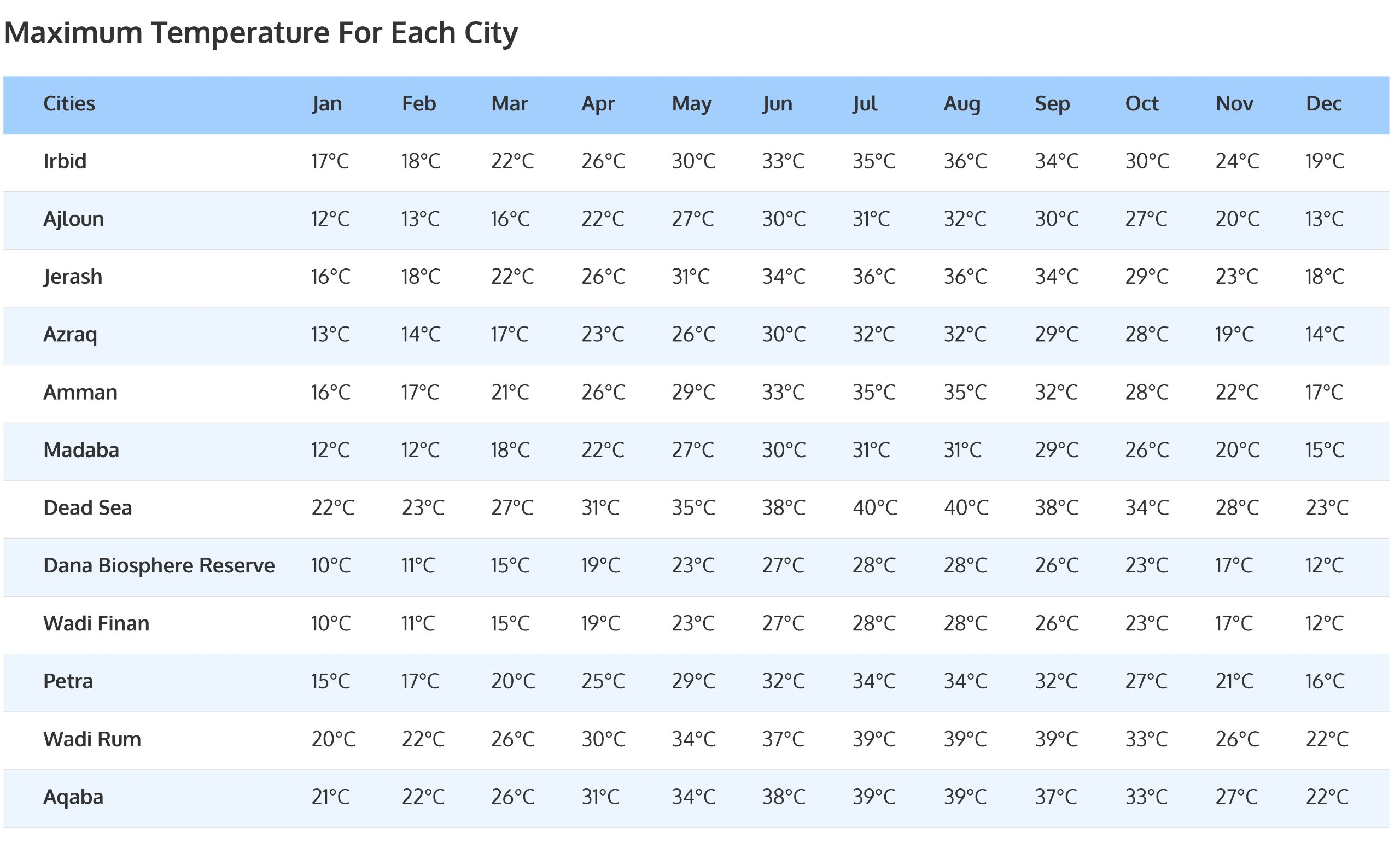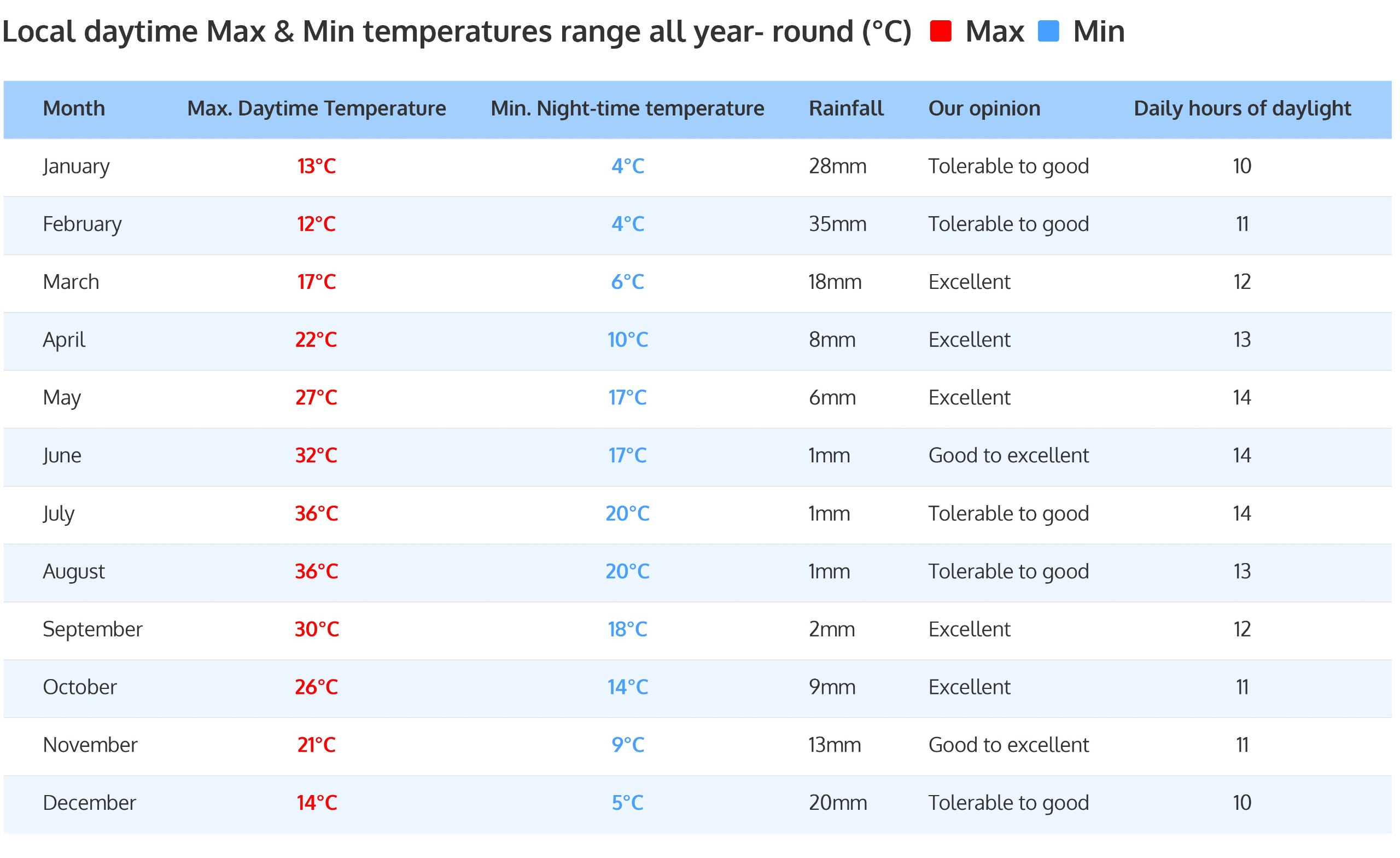Many people very sensibly ask about the weather in Jordan. The bellow useful tips would give you a very quick check of what the weather is doing in Jordan all year- around. You would think that it would help, but since it takes average temperatures, it doesn’t seem to all that much. When you are making plans, you should first of all remember that most of Jordan is high up, Amman is at 400m and Petra over 1000m. Given that the Dead Sea is below sea level and that Aqaba is very warm, you will understand that there is a great difference in the temperature between one place and another. Here we are talking basically about the medium conditions, and you should remember that ALWAYS the Dead Sea and Aqaba are hotter and drier. Also, please taken into account that one year is not always liken another year, just as happens elsewhere. All I can do is to give you the probabilities.
Jordan is actually a year- round destination, and has a typically Middle Eastern climate. While it is rainy and cold in Amman or Petra, it would be warm and pleasant at the Dead Sea or Aqaba. The visit to Jordan would be surprisingly adequate during Spring time “Mid- March- through mid-May” and Autumn time “Mid- September through mid-November” as the days are normally warm, with temperatures around 26-28ºC (78-84F), but during the nights, it might be cool. Summers are scorching here in Jordan with a temperatures reaching around or more than 40ºC (104F). If the heat doesn’t have that big impact in you, it is still worth considering a trip during this time of the year as most of the sites will be quieter and not crowded than other times of the year.
Summer is easy – it is hot everywhere. You can often find temperatures of 35-40°C in Petra; in that case, Wadi Rum and Aqaba will be higher! You cannot sightsee in Wadi Rum in these conditions, everybody finds somewhere in the shade to sleep. You can start to move about again from about 5pm. Much the same in Aqaba, the beach is most unpleasant in the afternoon, and you would be risking sunstroke to try to stay in the sea for long, unless you are diving. If snorkeling, you might get away with it, but be sure to wear a tee shirt against a sunburnt back.
End March to middle of May: mostly pleasant weather. Take a good pullover for the evenings, especially at the beginning of April. Rain is possible, but unlikely after the beginning of May. September and October are broadly similar, but of course, substitute “end October” for “beginning of April”.
Winter! this generally begins about the end of November – and it is cold! You can’t expect much better than 10-15°C during the daytime, and this when the sun is shining. Rain falls from November to March sometimes. Winters would be truly cold and wet, with the possibilities slight of snow sometimes “But it’s common to have snow every year”. The coldest months of the year are December and January, where temperatures average about 13 ºC degrees, but can drop to around 5 degrees especially during the night. The area which has altitude of 1000 meters and above, there is a chance of snowfall in winter, and apparently few have even had the chance to see Petra (1200 meters above sea level) in the snow.
In the Jordan Valley, around the Dead Sea and in Aqaba on the Red Sea the winters are warm and pleasant in winter time, and very hot during the summer. Wadi Rum is also cold, not much less so than Petra. It invariably freezes at night, but the daytime isn’t really too bad. But don’t have any illusions; you will need a warm jacket, preferably waterproof, just about everywhere. Actually, the massifs of Wadi Rum in the snow are quite spectacular! Petra is as well, but usually in rain or snow, access to Petra is not allowed.
Aqaba in the winter is the warmest place, but even here, high temperatures are unlikely to go over 20°C. The sea tends to be coldish. Aqaba is at the south end of Wadi Araba, there is invariably a good breeze to be felt, this turns into a lot of wind in the winter. Snorkeling conditions are not really good at this time.
Wind in Jordan, and especially in the desert areas, and around Petra, is very unpleasant indeed. It always brings a lot of dust and sand, sometimes one can experience a full blown sandstorm. The Sirocco (Also spelled Sirocco) starts at the end of March to the begging of May. It’s Called Also Khamaseen “from the Arabic world “Fifty” which lasts over a fifty- day period. It is a dry, hot, sandy wind passes over the area and lasting for several hours. It carries great quantities of sand and dust from the deserts blowing from the south in North Africa and the Arabian Peninsula.
On a number of occasions the Desert Highway has been closed because of bad visibility from the sand and dust. Driving in these conditions is not to be recommended. This sort of thing usually happens in the winter, but is by no means unknown in the spring and the autumn.

